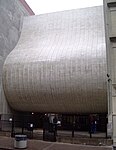ARChive of Contemporary Music
1985 establishments in the United StatesAC with 0 elementsMusic archivesMusic librariesMusic museums in New York (state) ... and 1 more
Music organizations based in the United States

The ARChive of Contemporary Music (ARC) is a non-profit music library and archive based in New York City. It contains over five million items.
Excerpt from the Wikipedia article ARChive of Contemporary Music (License: CC BY-SA 3.0, Authors, Images).ARChive of Contemporary Music
White Street, New York Manhattan
Geographical coordinates (GPS) Address Nearby Places Show on map
Geographical coordinates (GPS)
| Latitude | Longitude |
|---|---|
| N 40.71858 ° | E -74.00371 ° |
Address
White Street 54
10013 New York, Manhattan
New York, United States
Open on Google Maps





